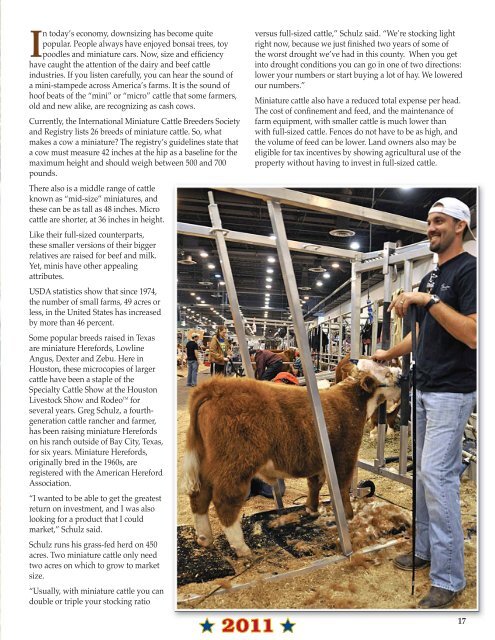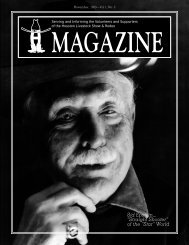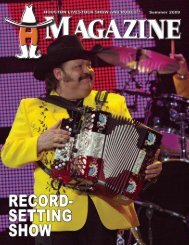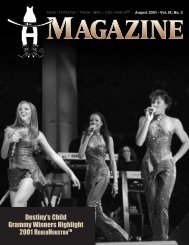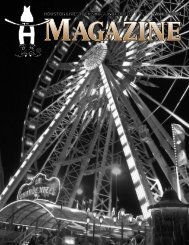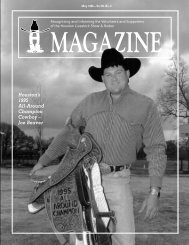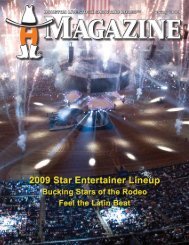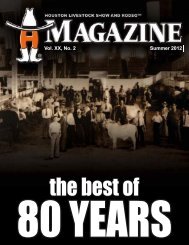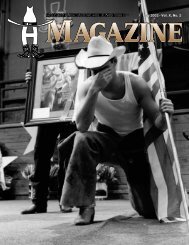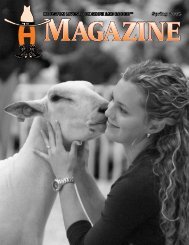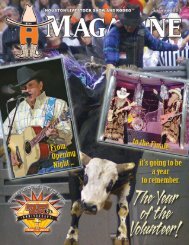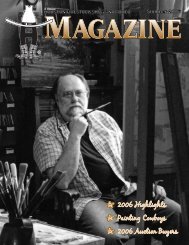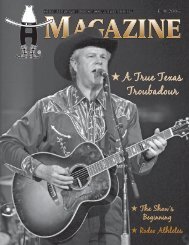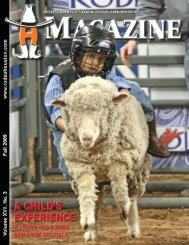trailblazer - Houston Livestock Show and Rodeo
trailblazer - Houston Livestock Show and Rodeo
trailblazer - Houston Livestock Show and Rodeo
Create successful ePaper yourself
Turn your PDF publications into a flip-book with our unique Google optimized e-Paper software.
In today’s economy, downsizing has become quite<br />
popular. People always have enjoyed bonsai trees, toy<br />
poodles <strong>and</strong> miniature cars. Now, size <strong>and</strong> efficiency<br />
have caught the attention of the dairy <strong>and</strong> beef cattle<br />
industries. If you listen carefully, you can hear the sound of<br />
a mini-stampede across America’s farms. It is the sound of<br />
hoof beats of the “mini” or “micro” cattle that some farmers,<br />
old <strong>and</strong> new alike, are recognizing as cash cows.<br />
Currently, the International Miniature Cattle Breeders Society<br />
<strong>and</strong> Registry lists 26 breeds of miniature cattle. So, what<br />
makes a cow a miniature? The registry’s guidelines state that<br />
a cow must measure 42 inches at the hip as a baseline for the<br />
maximum height <strong>and</strong> should weigh between 500 <strong>and</strong> 700<br />
pounds.<br />
There also is a middle range of cattle<br />
known as “mid-size” miniatures, <strong>and</strong><br />
these can be as tall as 48 inches. Micro<br />
cattle are shorter, at 36 inches in height.<br />
Like their full-sized counterparts,<br />
these smaller versions of their bigger<br />
relatives are raised for beef <strong>and</strong> milk.<br />
Yet, minis have other appealing<br />
attributes.<br />
USDA statistics show that since 1974,<br />
the number of small farms, 49 acres or<br />
less, in the United States has increased<br />
by more than 46 percent.<br />
Some popular breeds raised in Texas<br />
are miniature Herefords, Lowline<br />
Angus, Dexter <strong>and</strong> Zebu. Here in<br />
<strong>Houston</strong>, these microcopies of larger<br />
cattle have been a staple of the<br />
Specialty Cattle <strong>Show</strong> at the <strong>Houston</strong><br />
<strong>Livestock</strong> <strong>Show</strong> <strong>and</strong> <strong>Rodeo</strong> TM for<br />
several years. Greg Schulz, a fourthgeneration<br />
cattle rancher <strong>and</strong> farmer,<br />
has been raising miniature Herefords<br />
on his ranch outside of Bay City, Texas,<br />
for six years. Miniature Herefords,<br />
originally bred in the 1960s, are<br />
registered with the American Hereford<br />
Association.<br />
“I wanted to be able to get the greatest<br />
return on investment, <strong>and</strong> I was also<br />
looking for a product that I could<br />
market,” Schulz said.<br />
Schulz runs his grass-fed herd on 450<br />
acres. Two miniature cattle only need<br />
two acres on which to grow to market<br />
size.<br />
“Usually, with miniature cattle you can<br />
double or triple your stocking ratio<br />
versus full-sized cattle,” Schulz said. “We’re stocking light<br />
right now, because we just finished two years of some of<br />
the worst drought we’ve had in this county. When you get<br />
into drought conditions you can go in one of two directions:<br />
lower your numbers or start buying a lot of hay. We lowered<br />
our numbers.”<br />
Miniature cattle also have a reduced total expense per head.<br />
The cost of confinement <strong>and</strong> feed, <strong>and</strong> the maintenance of<br />
farm equipment, with smaller cattle is much lower than<br />
with full-sized cattle. Fences do not have to be as high, <strong>and</strong><br />
the volume of feed can be lower. L<strong>and</strong> owners also may be<br />
eligible for tax incentives by showing agricultural use of the<br />
property without having to invest in full-sized cattle.<br />
17


